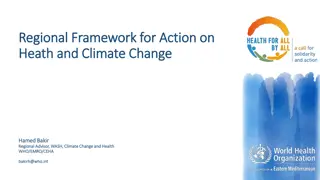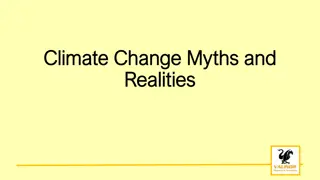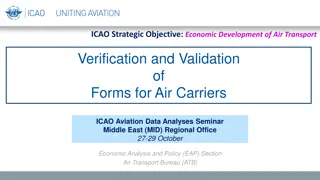Climate Change Monitoring, Reporting, and Verification (MRV) Training Session Overview
This document outlines the purpose and reporting requirements for the development of a Climate Change Monitoring, Reporting, and Verification (MRV) system, focusing on projections and scenarios. It highlights the importance of collecting information for climate mitigation, assisting Serbia in meeting international reporting obligations, and making projections publicly available. The content covers UNFCCC and EU regulations related to reporting on greenhouse gas emissions projections and removals, with details on methodologies, assumptions, and formats for presenting projections. Additionally, it emphasizes the significance of integrated reporting on greenhouse gas policies and measures as per EU Governance Regulation.
Download Presentation

Please find below an Image/Link to download the presentation.
The content on the website is provided AS IS for your information and personal use only. It may not be sold, licensed, or shared on other websites without obtaining consent from the author.If you encounter any issues during the download, it is possible that the publisher has removed the file from their server.
You are allowed to download the files provided on this website for personal or commercial use, subject to the condition that they are used lawfully. All files are the property of their respective owners.
The content on the website is provided AS IS for your information and personal use only. It may not be sold, licensed, or shared on other websites without obtaining consent from the author.
E N D
Presentation Transcript
D E V E L O P M E N T O F C L I M A T E C H A N G E M O N I T O R I N G , R E P O R T I N G A N D V E R I F I C A T I O N ( M R V ) S Y S T E M DELIVERABLE 7: TRAINING SESSION ON PROJECIONS AND SCENARIOS JUNE 2021 |
PURPOSE To collect and merge information on climate mitigation projections and scenarios To assist and enable Serbia to fulfil its international reporting obligations according to the UNFCCC (MPGs) and the EU Governance and its Implementing Regulation To visualise projected emissions trends (total and sectoral) To make projections and scenarios publicly available | 2
REPORTING REQUIREMENTS UNFCCC: The modalities, procedures and guidelines (MPGs) for the transparency framework for action and support, referred to in Article 13 of the Paris Agreement are defined in Decision 18/CMA.1. paras 92 102: Projections of greenhouse gas emissions and removals EU: Governance Regulation (EU 2018/1999) and Implementing Regulation (EU 2020/1208): Article 39: Reporting on national projections Annex XXIII of the Implementing Regulation are fully in line with the Paris Agreement reporting by 15thMarch 2021 and every two years thereafter; substantial changes to the information shall be communicated annually Serbian Climate Change Law Articles 62 to 65: Projections of greenhouse gas emissions and removals, and reporting | 3
UNFCCC Decision 18/CMA.1, paras 92 102: Projections of greenhouse gas emissions and removals, as applicable Countries shall report on scenarios with existing policies and measures and may report on scenarios with additional policies and measures. Each Party should provide information in describing the methodology used to develop the projections. This information should include: (a) Models and/or approaches used and key underlying assumptions and parameters used for projections (e.g. gross domestic product growth rate/level, population growth rate/level); (b) Changes in the methodology since the Party s most recent biennial transparency report; (c) Assumptions on policies and measures included in the with measures projections and with additional measures projections, if included; (d) Sensitivity analysis for any of the projections, together with a brief explanation of the methodologies and parameters used. Projections shall be presented in graphical and tabular formats. o o o | 4
EU GOVERNANCE REGULATION The reporting obligations concerning policy and measures are defined under the Governance Regulation (EU 2018/1999) and under Article 38 of the Implementing Regulation (EU 2020/1208). The format is laid down in Annex XXIII of the Implementing Regulation. | 5
EU GOVERNANCE REGULATION Article 18 Integrated reporting on greenhouse gas policies and measures and on projections 1. By 15 March 2021, and every two years thereafter, Member States shall report to the Commission information on: (a) their national policies and measures or group of measures as set out in Annex VI; and (b) (b) their national projections of anthropogenic greenhouse gas emissions by sources and removals by sinks, organised by gas or group of gases (Hydrofluorocarbons and Perfluorocarbons) listed in Part 2 of Annex V. National projections shall take into consideration any policies and measures adopted at Union level and shall include the information set out in Annex VII. | 6
EU GOVERNANCE REGULATION Annex VII Integrated reporting on greenhouse gas policies and measures and on projections (a) projections without measures where available, projections with measures, and, where available, projections with additional measures; (b) total GHG projections and separate estimates for the projected GHG emissions for the emission sources [ ]; (c) the impact of policies and measures [ ] (d) results of the sensitivity analysis performed for the projections and information on the models and parameters used; (e) all relevant references to the assessment and the technical reports that underpin the projections [ ] | 7
EU IMPLEMENTING REGULATION: ARTICLE 38 (1) Member States shall report the information on their national projections of anthropogenic greenhouse gas emissions by sources and removals by sinks, organised by gas or group of gases, referred to in Article 18(1)(b) and point (a) of Annex VII of Regulation (EU) 2018/1999 in the format set out in Annex XXV to this Regulation. CH4 N2O CO2 F gases Energy Waste LULUCF Industrial Processes Agriculture | 8
EU IMPLEMENTING REGULATION: ARTICLE 38 (2) Member States shall provide the additional information on their national projections [ ], specifying: the projection results for total greenhouse gas emissions [ ] the results of the sensitivity analysis performed [ ] for the total reported greenhouse gas emissions, together with a brief explanation of which parameters were varied and how; split on total emissions covered ETS, ESR, LULUCF the year of the inventory data (base year) and the year of the inventory report used as a starting point for the projections; the methodologies used for the projections, including a brief description of the models used and their sectoral, geographical and temporal coverage, references to further information on the models and information on data sources, key exogenous assumptions and on the parameters used | 9
EU IMPLEMENTING REGULATION: ARTICLE 38 (3) In the reports on projections, [ ], Member States shall take into account the harmonised values for key parameters for projections at least for oil, gas, and coal import prices as well as for carbon prices under the ETS which the Commission has recommended, in consultation with the Member States, 12 months before the deadline for submission of the reports. | 10
EU IMPLEMENTING REGULATION: ARTICLE 36 Union and national systems for policies and measures and projections By 1 January 2021, Member States [ ] shall operate and seek to continuously improve national [ ] systems [ ], for reporting on policies and measures and for reporting on projections of anthropogenic greenhouse gas emissions by sources and removals by sinks. Those systems shall include the relevant institutional, legal and procedural arrangements established within a Member State and the Union for evaluating policy and making projections of anthropogenic greenhouse gas emissions by sources and removals by sinks. | 11
SERBIAS CLIMATE CHANGE LAW Article 62 Projections of GHG Emissions from Sources and Removals by Sinks The Ministry shall prepare projections of anthropogenic GHG emissions from sources and their removals by sinks (hereinafter: projections) as a basis for determining and assessing the possibility of limiting GHG emissions, adopting policies and measures for economically viable limitation of GHG emissions, as well as for monitoring the GHG emission limitation. Projections are made for gases or groups of gases, as well as for sectors and categories, and improved if necessary. Projections for the relevant sectors are made in cooperation with the relevant Ministries. | 12
SERBIAS CLIMATE CHANGE LAW Article 63 GHG Policies, Measures and Projections Reporting System In order to ensure the timeliness, transparency, accuracy, consistency, comparability and completeness of information on policies, measures and projections, a system for reporting on GHG policies, measures and projections of shall be established, maintained and continuously improved. The system includes institutional, legal and procedural mechanisms for reporting on policies, measures and projections of anthropogenic GHG emissions from sources and removals by sinks. Bodies and organisations, including bodies and organisations of local self-governments in charge of environmental protection, shall assess the effects of policies and measures at the level of GHG emissions from their competence and report thereon to the Ministry. The Government shall determine the list of bodies and organisations referred to in paragraph 3 of this Article, the content, form and deadlines for reporting to the Ministry. | 13
RECOMMENDATIONS organise regular meetings with - all ministeries and organisations which are involved in the preparation of projections, - Most important data providers, and - members of the National Climate Change Committee. This ensures a common understanding of the assumptions and data used and scenarios which are agreed on by all relevant parties. January March (year X) Disaggregation of the base year emission inventories * data according to the structure required by models Processing of ETS data for the base year* and for key sources Processing of energy statistic data for the base year* prepare an annual time-line develop QA/QC procedures March June (year X) April July (year X) | 15
SUMMARY Set up a national system for projections and policies & measures, including stakeholders and data providers, with clear definitions and responsibilities for all functions Prepare GHG emission scenarios with existing measures and voluntarily with additional measures Share the results of your modelling exercise with all relevant ministries and stakeholders and with the national climate change committee Describe the models and the parameters used and the results of a sensitivity analysis, using the UNFCCC and EU reporting templates stored in the MRV IT tool Define indicators for different policies and measures to monitor their effect and to adjust your projections | 16
| 17
| 18
| 19























